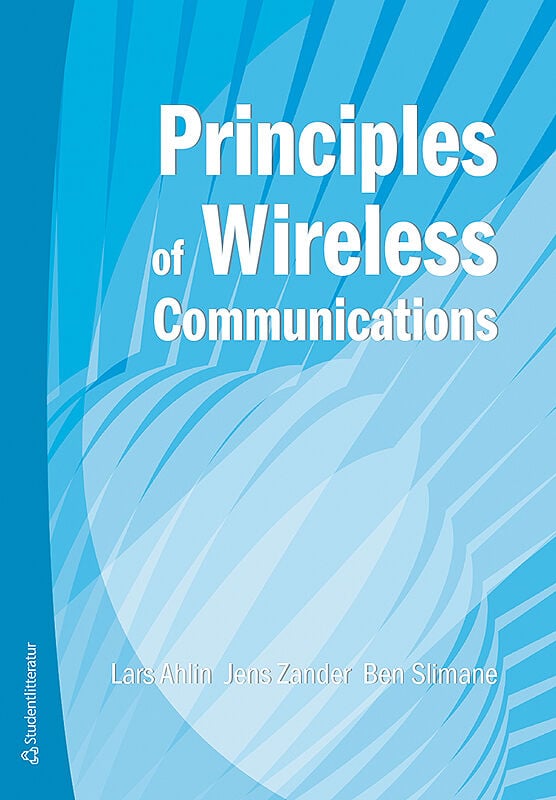Varukorg
Varukorgen är tom!
Varukorgen inkl. moms 0 kr
Elektronisk distribution
Frakt inkl. moms 0 kr
Varav moms (6 %) 0 kr
Varav moms (25 %) 0 kr
Öresutjämning 0 kr
Att betala inkl. moms 0 kr

Principles of Wireless Communications
- 1Preface
- 13Introduction
- 1.13Radio Communications Then and Now
- 1.26Communication Systems
- 1.2.17Communication Data Link Systems
- 1.2.212Network layer models
- 1.314Radio Communication Systems
- 1.415Managing the Radio Spectrum
- 1.4.115Standardization Organizations
- 1.524Overview of Radio Systems
- 1.5.124Radio Services
- 1.5.227Typical Properties of the Frequency Bands
- 233Propagation
- 2.133Electromagnetic Fields Fundamentals
- 2.236Propagation Basic Principles
- 2.2.136Propagation Mechanisms
- 2.2.247Reflection
- 2.2.352Diffraction
- 2.2.458Scattering
- 2.358Tropospheric Propagation
- 2.3.159Refraction in Normal Atmosphere
- 2.3.260The Laws of Refraction
- Contents
- 2.3.365Microwave Link Path
- 2.3.469Tropospheric Phenomena
- 2.471Ionospheric Propagation
- 2.4.171The Ionosphere
- 2.4.276Propagation under Normal Ionospheric Conditions
- 2.4.381Prediction of Ionospheric Links
- 2.583Propagation Modelling
- 2.5.183Basic Principles
- 2.5.284Macrocells Models
- 2.5.391Microcells Models
- 2.5.493Indoor Models
- 96Problems
- 3101Wireless Link Design
- 3.1101Radio Receiver Design
- 3.1.1103Software Radios
- 3.1.2104Radio Transmitter Design
- 3.2106Antenna Design
- 3.2.1107The Antenna as an Electrical Component
- 3.2.2110The EM-Field around the Antenna
- 3.2.3114Some Simple Antenna Types
- 3.2.4116Directional Antennas
- 3.3123Channel Modelling
- 3.4125Time-Invariant Channel Models
- 3.5132Time-Variant Channel Models
- 3.6136Stochastic Channel Models
- 3.6.1137Correlation Properties
- 3.6.2143Fading Channel Distorsion
- 3.7148Properties of Flat Fading Signals
- 3.8151Channel Models for Mobile Radio Systems
- 3.8.1152Slowly, Flat Fading
- 3.8.2157Shadowing
- 3.9159Link Budget Calculations
- 3.9.1159Additive Noise
- 3.9.2161Noise Power
- 3.9.3164Link Budgets
- 3.10169Fade Margin and Time Availability
- 174Problems
- 4187Data Transmission over Radio Channels
- 4.1187Introduction
- 4.2195Digital Modulated Signals on AWGN Channels
- 4.2.1195Coherent Detection
- 4.2.2202Non-coherent Detection
- 4.2.3208Power Spectral Density of Digitally Modulated Signals
- 4.3211Linear Modulation Techniques
- 4.3.1212Spectral Properties of Linearly Modulated Signals
- 4.3.2214Amplitude Modulation
- 4.3.3217Coherent Phase Shift Keying
- 4.3.4229Differential Phase Shift Keying
- 4.4234Non-Linear Modulation Techniques
- 4.4.1235Coherent Frequency Shift Keying
- 4.4.2242Continuous Phase Frequency Shift Keying
- 4.4.3246Continuous Phase Modulation
- 4.4.4248Non-Coherent Frequency Shift Keying
- 4.5252Data Transmission over Flat Fading Channels
- 4.5.1252Slowly Flat Fading Channels
- 4.5.2260Fast Flat Fading Channels
- 4.6Data Transmission over Frequency Selective
- 264Fading Channels
- 4.6.1264Channel Model of Frequency Selective Fading
- 4.6.2272Linear Equalization Techniques
- 4.6.3281Nonlinear Equalization Techniques
- 4.7289Orthogonal Frequency Division Multiplexing
- 4.7.1294OFDM Signals on AWGN Channels
- 4.7.2295Spectral Properties of OFDM Signals
- 4.7.3297OFDM Signals over Fading Multi-path Channels
- 4.7.4306Discrete Representation of OFDM Signals
- 4.8309Spread Spectrum Modulation
- 4.8.1311Direct Sequence Spread Spectrum Modulation
- 4.8.2321Frequency Hop Spread Spectrum Modulation
- 4.8.3327Time Hop Spread Spectrum Modulation
- 4.8.4328Multi-Carrier Spread Spectrum Modulation
- 336Problems
- 5353Diversity Systems
- 5.1354Principle of Diversity
- 5.2355Microscopic Diversity Methods
- 5.3360Combining Methods
- 5.3.1361Selection Combining
- 5.3.2366Maximal Ratio Combining
- 5.3.3370Equal Gain Combining
- 5.3.4375Switched Combining
- 5.4379Practical Limitations of Diversity Systems
- 5.4.1379Pre-detection and Post-detection Combining
- 5.4.2379Correlated Branch Signals
- 5.4.3381The Effects of Correlated Noise
- 5.5382Bit Error Performance of Diversity Systems
- 5.5.1382Maximal Ratio Combining
- 5.5.2388Selection Combining
- 5.5.3392Switched Combining
- 5.6394Spatial Multiplexing
- 5.6.1395Multiple Antenna Systems
- 5.6.2401Space-Time Coding Systems
- 410Problems
- 6419Error Control Coding for the Radio Channel
- 6.1421Discrete Channel Models
- 6.1.1423Memoryless Channels
- 6.1.2428Models for Burst Error Channels
- 6.2435Block Codes
- 6.2.1435Basic Properties
- 6.2.2437Distance Properties
- 6.2.3442Types of Block Codes
- 6.2.4446Decoding of Block Codes
- 6.3464Convolutional Codes
- 6.3.1465Basic Properties
- 6.3.2471Decoding of Convolutional Codes
- 6.3.3475Performance in AWGN Channels
- 6.4481Coding Methods for Fading Channels
- 6.4.1483Coding and Interleaving
- 6.4.2486FEC Schemes with Full Interleaving
- 6.4.3496Concatenated Codes
- 6.4.4499Parallel Concatenated Convolutional Codes
- 6.5503Coded Modulation Techniques
- 6.5.1506Design of Trellis Coded Modulation
- 6.5.2512Performance of TCM Codes on AWGN Channels
- 6.5.3514Performance of TCM Codes on Fading Channels
- 522Problems
- 7533Multi-User Communications
- 7.1533Background and De_nitions
- 7.2536Signal Set Design in Multi-User Systems
- 7.3546Orthogonal Multiple Access Systems
- 7.3.1546Frequency Division Multiple Access Systems
- 7.3.2549Time Division Multiple Access Systems
- 7.3.3Orthogonal Frequency Division Multiple Access Systems
- 553
- 7.4555Spread-Spectrum Multiple Access Systems
- 7.4.1Frequency Hop-Code Division Multiple Access Systems
- 555
- 7.4.2Direct Sequence-Code Division Multiple Access Systems
- 558
- 576Problems
- 8585Wireless Packet Transmission
- 8.1585Introduction
- 8.2590Wireless link transmission
- 8.2.1591Basic Properties
- 8.2.2593Basic ARQ Schemes
- 8.2.3602Undetected Error Performance of ARQ Systems
- 8.2.4605ARQ Systems for Burst Error Channels
- 8.2.5608Comparison between ARQ and FEC System
- 8.2.6609Type I Hybrid FEC/ARQ Schemes
- 8.2.7611Type II Hybrid FEC/ARQ Schemes
- 8.3614Wireless Access Protocols
- 8.3.1614Wireless Access Models
- 8.3.2622The ALOHA-Algorithm
- 8.3.3629Power Capture
- 8.3.4632Carrier Sense Multiple Access (CSMA
- 8.4633Some packet access examples
- 642Problems
- 9649Wireless Networks
- 9.1649Basic Concepts
- 9.2655Spectrum reuse fundamentals
- 9.3660Cellular Networks
- 9.3.1660Basic Concepts
- 9.3.2676Re_ned Capacity Analysis
- 9.3.3685Directional Antennas in Cellular Networks
- 9.3.4688Non-Blocking Systems
- 9.4694Spread spectrum cellular systems
- 9.4.1694Frequency Hopping
- 9.4.2698CDMA systems
- 704Problems
- 714Answers to Problems
Information
- Författare:
- Lars Ahlin Ben Slimane Jens Zander
- Språk:
- Svenska
- ISBN:
- 9789144126531
- Utgivningsår:
- 2006
- Revisionsår:
- 2018
- Artikelnummer:
- 31430-02
- Upplaga:
- Andra
- Sidantal:
- 740